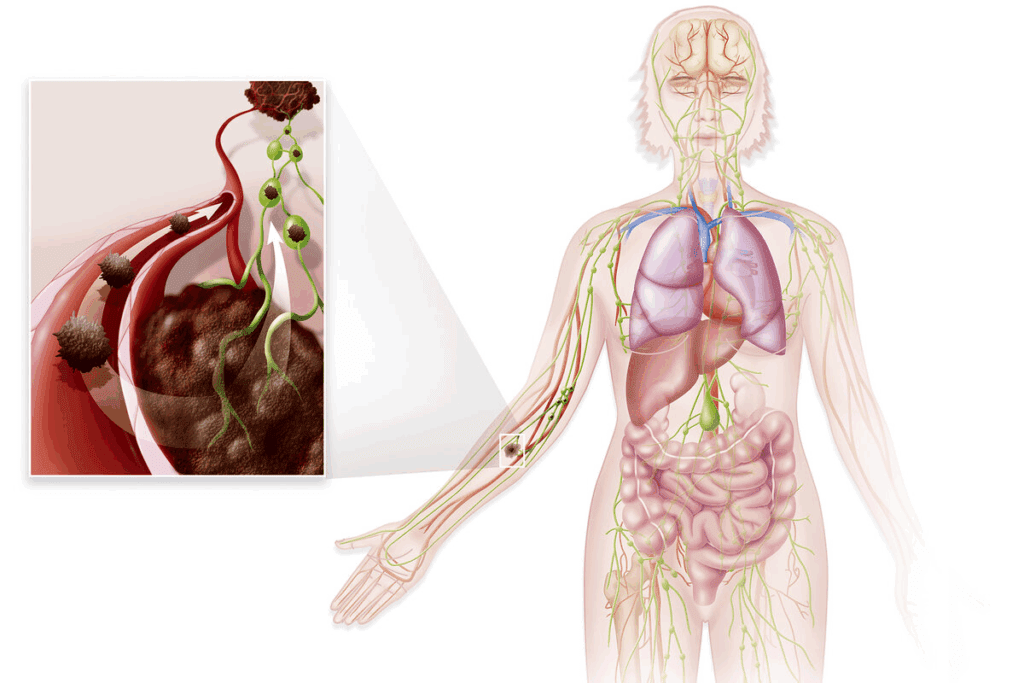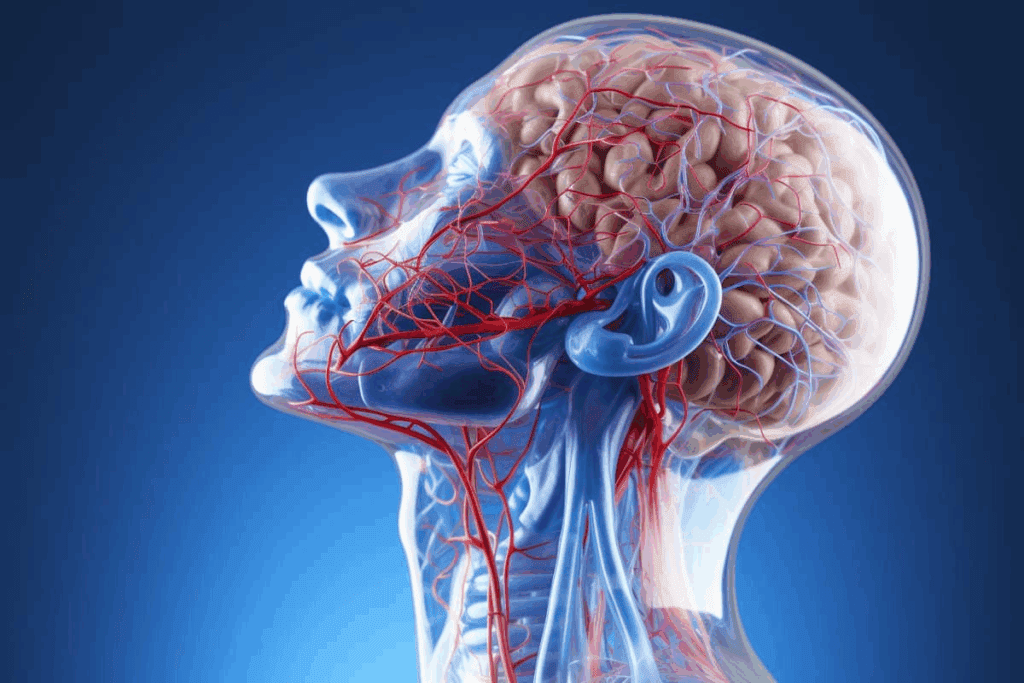Last Updated on November 20, 2025 by Hozen

Ever felt a small bump at the back of your head and wondered what it could be? It’s important to know about occipital lymph nodes. They help fight off infections and can signal health issues.
The occipital lymph nodes are found near the occipital bone and the superior nuchal line. They usually number from 1 to 10. You can find them at the lateral border of the trapezius muscle near the occipital bone.
At Liv Hospital, we offer expert care and compassion. We help you understand swollen lymph nodes with confidence and clarity.
Where are lymph nodes at the back of head located? Find the occipital nodes and understand why they become palpable.

The lymphatic system is key to our immune defense. It’s a network of vessels, organs, and tissues. It helps protect us from infections and diseases.
It filters out harmful substances and cells, keeping us healthy. Lymph nodes are important in this system. They filter lymphatic fluid and remove germs, damaged cells, and cancer cells. This is vital for our immune response.
Lymph nodes have several important roles:
These roles are key to keeping us healthy and stopping infections from spreading.
Lymph nodes are found all over the body. They are in the neck, armpits, and groin. They also line the lymphatic vessels, which carry lymphatic fluid.
Knowing where lymph nodes are and what they do is important. It helps us understand how our body fights off infections and diseases. The lymphatic system works together to keep us healthy.

The occipital lymph nodes are at the back of the head. They help drain lymph from the scalp. This network supports the immune system and overall health.
The occipital lymph nodes are near the occipital bone, which is at the back and base of the skull. This spot helps them drain lymph from the scalp. The precise location of these nodes is typically along the occipital artery, which supplies blood to the scalp.
Knowing where the occipital lymph nodes are is key for doctors. It helps them diagnose and treat head and neck issues. The nodes are in a specific area, making their anatomy very important for medical care.
The trapezius muscle is a major back muscle. It connects from the skull to the thoracic spine. It helps move the scapula and supports the arm.
Understanding the anatomy of the occipital lymph nodes is vital. It helps doctors diagnose and manage issues in this area. Knowing their relationship with the trapezius muscle and occipital bone is key.
It’s key to know about the occipital lymph nodes to diagnose and treat issues. These nodes are at the back of the head. They help drain the scalp’s back part.
These nodes are split into two types: superficial and deep. This split is based on where they sit relative to the fascia, a tissue layer.
The superficial nodes are close to the skin’s surface, near the occipital bone. They handle the scalp’s back part drainage.
The deep nodes are further down, along the occipital artery. They get lymph from the scalp’s deeper parts. They’re key for immune checks.
To grasp the structure and types of these nodes, let’s dive into their differences.
| Characteristics | Superficial Occipital Lymph Nodes | Deep Occipital Lymph Nodes |
| Location | Near the surface of the skin, close to the occipital bone | Along the occipital artery, deeper in the tissue |
| Function | Drain the posterior part of the scalp | Receive lymph from deeper structures of the scalp |
| Role in Immune Response | Initial immune response to superficial infections | Immune surveillance for deeper infections or malignancies |
Occipital lymph nodes are key parts of the lymphatic system. They filter lymphatic fluid from the back of the scalp. These nodes help keep the scalp and neck healthy by draining fluid and boosting the immune system.
The occipital lymph nodes mainly drain fluid from the back of the head. This includes the skin and tissues behind the head. It’s important to remove harmful substances and cells from this fluid.
The occipital lymph nodes also protect the head and neck from infections. They filter out harmful substances and cells. This helps prevent diseases in these areas.
Key functions include:
In summary, the occipital lymph nodes are vital for draining fluid and protecting the head and neck. Their health is important for overall well-being. Any problems with these nodes could mean there’s an underlying health issue.
The pericervical lymphoid ring is a structure made of lymph nodes. It protects the body by fighting off infections. This ring is key for the immune system in the head and neck.
The ring is made up of several lymph node groups. These include the occipital, mastoid, parotid, submandibular, and submental lymph nodes. Each group helps drain lymph from different parts of the head and neck.
Let’s look at the main parts of the pericervical lymphoid ring:
The occipital lymph nodes are linked to other groups through lymphatic vessels. This network helps drain lymph from the scalp and head to deeper nodes in the neck.
Here’s a simple overview of how the occipital lymph nodes connect to others:
| Lymph Node Group | Connection to Occipital Nodes | Drainage Area |
| Mastoid lymph nodes | Lymphatic vessels | Posterior auricular region |
| Parotid lymph nodes | Lymphatic vessels | Parotid gland and surrounding areas |
| Submandibular lymph nodes | Lymphatic vessels | Anterior part of the neck and floor of the mouth |
Knowing about the pericervical lymphoid ring and its parts is vital. It helps in diagnosing and treating lymph node issues in the head and neck.
It’s important to know why lymph nodes at the back of the head swell. This knowledge helps in finding the right treatment. Swollen lymph nodes can come from infections, inflammation, or diseases that affect the whole body. Let’s dive into these reasons to understand the issue better.
Scalp infections often cause swollen lymph nodes at the back of the head. These infections can be caused by bacteria, fungi, or viruses. For example, conditions like folliculitis, impetigo, or ringworm can make lymph nodes swell as the body fights off the infection.
Common scalp infections include:
Viral and bacterial infections are big reasons for swollen lymph nodes. Viral infections like the common cold, flu, and mono are common culprits. Bacterial infections, such as strep throat or skin infections, can also make lymph nodes swell.
| Infection Type | Common Causes | Symptoms |
| Viral | Common cold, flu, mono | Fever, sore throat, fatigue |
| Bacterial | Strep throat, skin infections | Sore throat, skin lesions, fever |
Itchy scalp conditions, like dandruff, eczema, or contact dermatitis, can also cause swollen lymph nodes. The body’s immune response to these conditions can make the lymph nodes swell.
“The itchy scalp conditions can be quite uncomfortable and may lead to swollen lymph nodes as the body reacts to the irritation.”
Systemic conditions, including autoimmune diseases like rheumatoid arthritis or lupus, can also affect the occipital lymph nodes. Certain cancers, such as lymphoma, can also cause swollen lymph nodes at the back of the head.
We’ve talked about many reasons for swollen lymph nodes at the back of the head. These include infections, inflammatory conditions, and systemic diseases. Knowing these causes is key to finding the right treatment.
The symptoms of occipital lymphadenopathy can differ from person to person. Swollen occipital lymph nodes can cause various noticeable symptoms. It’s important to understand and observe these symptoms carefully.
Swelling at the back of the head is a common symptom. This swelling can be on one side (unilateral) or both sides (bilateral). Unilateral swelling might point to a localized issue, while bilateral swelling could suggest a broader problem.
Pain and tenderness at the base of the skull are common symptoms. The pain can be mild or severe and worsen with movement or pressure. Often, this tenderness is accompanied by headaches or neck stiffness.
Other symptoms may include fever, fatigue, and general malaise if the swelling is due to an infection. Some people may also experience weight loss or night sweats, which could indicate a serious issue.
It’s vital to watch these symptoms closely and seek medical help if they don’t improve or get worse. Understanding these symptoms helps in diagnosing and treating the underlying causes.
It’s important to know about serious conditions that can affect the occipital lymph nodes. These nodes are key to our immune system. When they get involved in diseases, it can be serious.
Lymphoma is a cancer that starts in the lymphatic system. It can show up in the occipital lymph nodes. There are two main types: Hodgkin lymphoma and non-Hodgkin lymphoma. Non-Hodgkin lymphoma is more likely to affect these nodes.
Symptoms of lymphoma in these nodes include:
To diagnose lymphoma, doctors use imaging studies, biopsy, and lab tests. Treatment depends on the type and stage of lymphoma. It might include chemotherapy, radiation, or immunotherapy.
Metastatic cancer to the occipital lymph nodes happens when cancer spreads from another part of the body. Skin cancers, like melanoma, and head and neck cancers are common culprits.
Important things about metastatic cancer in these nodes include:
While serious conditions can affect these nodes, many swollen lymph nodes are not serious. But, any lasting or unusual swelling needs a doctor’s check-up.
Diagnosing lymph node problems at the back of the head combines physical checks and advanced imaging. We’ll cover the steps to check for issues with lymph nodes at the back of the head.
A detailed physical check is the first step in finding problems with lymph nodes at the back of the head. Doctors use touch to feel the size, tenderness, and feel of the lymph nodes.
During the check, the patient sits or stands comfortably. This lets the doctor easily reach the back of the head. The doctor gently feels the area with their fingers to look for any oddities.
If a physical check shows something odd or if more info is needed, imaging tests are used. These tests include ultrasound, CT scans, and MRI.
| Imaging Modality | Description | Use in Diagnosing Occipital Lymphadenopathy |
| Ultrasound | Uses high-frequency sound waves to create images of the lymph nodes. | Helps assess the size and characteristics of lymph nodes, guiding fine-needle aspiration if needed. |
| CT Scan | Provides detailed cross-sectional images of the body’s internal structures. | Useful for evaluating the extent of lymph node enlargement and detecting any associated masses or lesions. |
| MRI | Offers high-resolution images of soft tissues, including lymph nodes. | Particularly useful for assessing the relationship between lymph nodes and surrounding structures, as well as detecting any abnormalities in the lymph nodes themselves. |
If imaging tests don’t give clear answers or if cancer is suspected, a biopsy might be done. This involves taking a tissue sample from the lymph node for detailed examination.
Fine-needle aspiration biopsy (FNAB) is a common method for taking samples from lymph nodes. It’s less invasive than surgery and can give important clues about what’s going on.
Treating swollen lymph nodes at the back of the head starts with finding the cause. Knowing what’s causing the swelling is key to managing it well.
To tackle swollen occipital lymph nodes, finding and fixing the root cause is vital. This might mean:
Medicine is a big part of treating swollen occipital lymph nodes, based on the cause.
In some cases, pain relief medication is suggested to ease discomfort from swollen lymph nodes.
For mild swelling, some home remedies can help:
Seeing a healthcare professional is important to find the right treatment. Home remedies can help with mild symptoms, but they shouldn’t replace medical advice and treatment.
Understanding the lymph nodes at the back of the head is key to knowing our lymphatic system’s role in health. We’ve looked at the anatomy and function of these nodes. We’ve also talked about their possible problems and related conditions.
The occipital lymph nodes are important for draining the back of the scalp. They help protect the head and neck from infections. Knowing about these nodes helps us see how the lymphatic system works together.
We’ve talked about different issues that can affect these nodes. This includes infections, inflammation, and serious diseases like lymphoma and cancer. Being aware of these can help us get medical help when needed.
In short, the occipital lymph nodes are vital for our immune system. Knowing about their function and possible problems is important for staying healthy. By learning more about the lymphatic system, we can better appreciate how it keeps us well.
The occipital lymph nodes are found at the side of the trapezius muscle. They are near the occipital bone. They play a key role in the lymphatic system.
The lymphatic system is essential for our immune defense. Lymph nodes act as filters for harmful substances. They help keep our body healthy.
Swollen occipital lymph nodes can be due to infections, inflammatory conditions, or systemic diseases. It’s important to get a proper diagnosis and treatment.
Symptoms include swelling, pain, and tenderness at the base of the skull. Other symptoms may also appear, requiring medical attention.
Yes, lymphoma can affect the occipital lymph nodes. It’s important to understand serious conditions that can impact these nodes.
Diagnosis involves physical exams, imaging studies, and biopsies. These methods help accurately assess conditions affecting the occipital lymph nodes.
Treatment aims to address the underlying cause. Medications are available for different conditions. Home care remedies can help with mild swelling.
Yes, there are lymph nodes on the head, including the occipital lymph nodes. They are vital for immune defense in the head and neck.
The pericervical lymphoid ring is a key part of the lymphatic system. It includes various lymph node groups, including the occipital lymph nodes. Together, they defend the head and neck.
Yes, metastatic cancer can spread to the occipital lymph nodes. It’s important to understand how these nodes can be involved in serious health conditions.
National Health Service (NHS). (2025). Where Are Lymph Nodes at the Back of. Retrieved from https://www.nhs.uk/conditions/swollen-glands/
Subscribe to our e-newsletter to stay informed about the latest innovations in the world of health and exclusive offers!